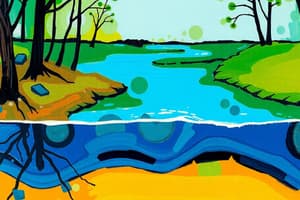Podcast
Questions and Answers
Who first proposed the idea of continental drift?
Who first proposed the idea of continental drift?
Alfred Wegener
What was the name of the supercontinent suggested by Alfred Wegener?
What was the name of the supercontinent suggested by Alfred Wegener?
Pangaea
What does the theory of plate tectonics explain?
What does the theory of plate tectonics explain?
The movement of Earth's lithospheric plates
What are the three well-defined phases of geological work by a river?
What are the three well-defined phases of geological work by a river?
What are the two main types of tectonic plates?
What are the two main types of tectonic plates?
Which natural agents are involved in the erosion of rocks and soil materials?
Which natural agents are involved in the erosion of rocks and soil materials?
What is the composition of oceanic plates?
What is the composition of oceanic plates?
What are the most powerful subaerial agents of erosion?
What are the most powerful subaerial agents of erosion?
What is the composition of continental plates?
What is the composition of continental plates?
How are valleys defined in relation to rivers?
How are valleys defined in relation to rivers?
What are waterfalls and how are they formed?
What are waterfalls and how are they formed?
What are some other subaerial agents of erosion mentioned in the text?
What are some other subaerial agents of erosion mentioned in the text?
What is the water table?
What is the water table?
What is the vadose zone?
What is the vadose zone?
What is the capillary fringe?
What is the capillary fringe?
What is a perch water table?
What is a perch water table?
How does groundwater move through rocks underground?
How does groundwater move through rocks underground?
What is an aquifer?
What is an aquifer?
Why is knowledge of subsurface geology important for foundation design?
Why is knowledge of subsurface geology important for foundation design?
Why is it important for civil engineers to comprehend the surveying and investigation process of a site?
Why is it important for civil engineers to comprehend the surveying and investigation process of a site?
How does geology help in site selection and land use planning for infrastructure projects?
How does geology help in site selection and land use planning for infrastructure projects?
What are the five steps involved in the surveying and investigation process of a site?
What are the five steps involved in the surveying and investigation process of a site?
What role do geologists play in slope stability and landslide analysis?
What role do geologists play in slope stability and landslide analysis?
Why is it mentioned that a single civil engineer cannot complete all surveying work on their own for every project?
Why is it mentioned that a single civil engineer cannot complete all surveying work on their own for every project?
What is an Aquiclude?
What is an Aquiclude?
Define Aquitard.
Define Aquitard.
What is an Aquifuge?
What is an Aquifuge?
What characterizes a Confined Aquifer?
What characterizes a Confined Aquifer?
What is a Leaky Aquifer?
What is a Leaky Aquifer?
How does an Aquitard differ from an Aquiclude?
How does an Aquitard differ from an Aquiclude?
Flashcards are hidden until you start studying




